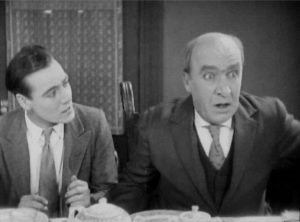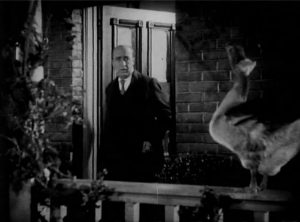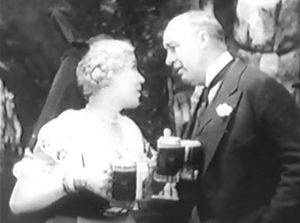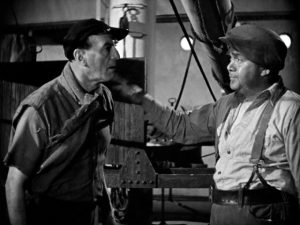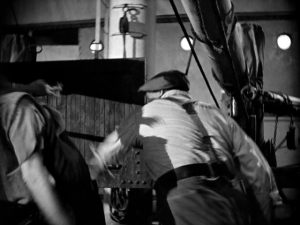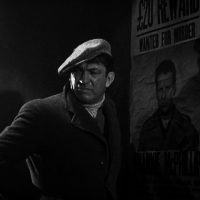
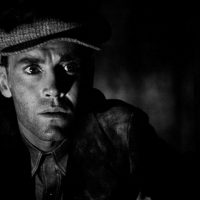
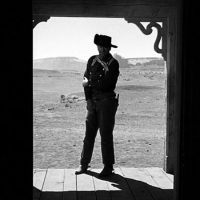
Victor McLaglen, shrouded in the Dublin fog, guiltily contemplating the reward poster which looms over him; Henry Fonda, crouched in shadow, the gleam and intensity in his eyes penetrating the darkness; John Wayne standing alone in the desert, isolated by the blackness of the doorway that surrounds him. These are the images that flicker across our collective consciousness when the name of John Ford is mentioned – the poster images of the John Ford oeuvre. They testify to Ford’s talent for the lighting and composition of human subjects; for the depiction of figures whose fates are totally bound up in the plays of light and shadow that surround them, and the landscapes that dominate their world. They also give us a beauty that, if not exactly austere, certainly does not testify to Ford’s great talent for comedy.
It is a shame that so many of the films which have now become canonized as the ‘classic’ Ford pictures are so often unrepresentative of the playfulness and comic sensibilities that characterise so much of his work. His popular legacy as a director of westerns means that his comic films are often overlooked, and when they are not it is often assumed that his later comedies are more meaningful, bringing with them a more deeply ingrained sensibility. What follows is a slightly revised version of my undergraduate dissertation which attempts to demonstrate that not only are Ford’s comedies just as rich and rewarding as some of his more acclaimed works, but that the roots of the comic style he utilised in later films can be found in the very earliest years of his career.
I’m dividing the piece into three separate posts. In the first I‘ve looked at Ford’s earliest comedies, and discussed how far they were influenced by his Irish heritage. In the second I examine the star comedies that Ford made at Fox, and ask how he was able to modify their generic demands to suit his own style. In the third I will demonstrate what implications Ford’s working methods have for his status as an ‘auteur’.
Because of the critical neglect that many of these films have suffered, I have tried to discuss them not only as part of my central argument, but also as fascinating pieces in their own right. As this was originally written as a dissertation there may still be passages which seem a little too eager to prove my engagement with relevant theory, but I hope these parts, particularly my conclusion – which questions the usefulness of certain methodologies when dealing with historical films – will still prove to be interesting and thought-provoking reads.
“I feel I’m essentially a comedy director, but they won’t give me a comedy to do.”
John Ford, 1960s
At the beginning of his career, John Ford spent six years making Western programmers for Universal under the name of ‘Jack’ Ford, before signing with Fox in 1923 and adopting the name by which we now know him.[i]
With this change of name came a more diverse range of films, and as well as Westerns he began to make rural melodramas, moody experiments in expressionism, and comedies. Although the three silent comedies he made in the twenties represent the minority of his work during this period, they still provide a useful model of his comic style, introducing devices that would continue to characterize his films throughout his career. In particular, they provide strong examples of Ford’s attitude toward his Irish ancestry, and to his own brand of stereotyping. Though his two Irish comedies provide more fertile ground for analysis, it is useful to first look at Lightnin’.
As the majority of Ford’s silent work is now lost, it is difficult to say when he directed his first comedy, or indeed when he began to incorporate humour into his work. Of the films that survive, the earliest that displays any real comic tendencies is Lightnin’ (1925), an adaptation of a hit play of the same name which had begun on Broadway in 1918, becoming a box office smash and breaking the record for the longest consecutive run of a single play of all time with 1,291 performances.[ii]
Eager to capitalise on this success, Fox bought the rights from producer John Golden as part of a $1 million deal that was encouraged by MPPDA president Will Hays as a means of creating clean but commercial entertainment.[iii] It was then assigned to Ford, who was fresh from the success of one of 1924’s biggest pictures, The Iron Horse, and would therefore provide capable hands for an adaptation.
The play tells the story of the ironically named “Lightnin’” Bill Jones, who is thrown out by his wife when he refuses to agree to the sale of their hotel, built on the California/Nevada state line, to protect her from swindlers. The land scam plot is similar to the kinds of stock Western stories that Ford had worked on in his days at Universal, but this time he had the added burden of adapting the comedy from a dialogue-driven play into a form suitable for a silent film. Ford had always disliked excessive dialogue,[iv] and consequently many of the jokes seem to have been lost in the process. A 1918 review of the play in The New York Times described the titular character thus:
“Is crime the subject under discussion? Lightnin’ has been a detective. Or if law comes up, Lightnin’ has been a judge. Should the conversation veer to bees, Lightnin’ is none the less at home. He drove a swarm of bees across the desert in the dead of winter, and without losing a bee.”[v]
Only the last of those conversations ever makes it into a film, and when it does it feels more like a throwaway one-liner than an attempt to deepen our understanding of the character. Lightnin’s great talent for telling tall tales seems to have been largely excised, and Ford settles with depicting him as being simply a shiftless drunk. As with Riley the Cop, the fact that the film was made in prohibition era meant that the depiction of excessive drinking, a favourite comic motif of Ford’s, could almost be used a punchline in its own right, as it now became an act of gleeful subversion.
One of the most comic scenes in the film is one in which a sheriff attempts to arrest a lawyer who is jumping back and forth across the state line, and in and out of his jurisdiction. This lengthy scene is played in one long shot, looking directly into the room, and is clearly taken wholesale from the play, as it is one of the few times that a shot feels like it has been staged from the point of view of a theatre audience.
Elsewhere there are a number of visual gags which were clearly invented for the film, such as a scene involving two drunks sitting on top of a trapdoor and bouncing confusedly as someone tries to come up from beneath, a close-up of a pompous poster of J. Farrell MacDonald which cuts back to show him in the exact same pose, admiring his own image, and several cutaway shots of a pampered dog in a sweater.
In all there is perhaps just enough visual invention to compensate for any jokes which got lost in translation, a view confirmed by The New York Times review of the film:
“Mr. Ford has done a difficult job mighty well. Too much praise cannot be given for the way he has chosen his material out of the play and invented other material in keeping, and for the taste he has displayed and shrewd observation of the entertaining foibles of everyday humanity…There is plenty of real humor and genuine pathos in “Lightnin'”. If you insist on more complicated emotions, try elsewhere.”[vi]
In retrospect, this review seems remarkably astute. Throughout Ford’s career he would be consistently praised for his skill in finding small touches to illustrate character, for his keen observation of the ‘foibles of everyday humanity’, and for the way in which he used moments of humour and pathos to make up for a lack of complex characterization.
Though it may have been a portent of things to come, Lightnin’ has largely been ignored by critics and Ford biographers since, with Scott Eyman writing that “the humour seems ponderous and mostly in the subtitles.”[vii] Even Tag Gallagher’s fairly comprehensive study of Ford’s films overlooks it, and he charts Ford’s comic style as beginning a year later, with The Shamrock Handicap.[viii]
Ford’s 1926 film, The Shamrock Handicap, was a sentimental film about an Irish jockey who travels to America to make his fortune, later being joined by his fiancée and her family who must work together to help their horse Dark Rosaleen win the big race and pay off their debts. Horse racing was a popular sport at the time, with the rise of ‘celebrity’ horses such as Man o’ War, and renewed prosperity after World War I, meaning that spectators flocked to the race tracks.[ix] Ford had previously made a horse-racing movie in 1925 with Kentucky Pride, a film told through the eyes of the horse, and had capitalised on the flourishing popularity of the sport by featuring a cameo from Man o’ War himself. It was natural, therefore, that Ford attempt to emulate this success with another equestrian-themed film.
More important to Ford however, was the chance to put Ireland on screen. A second-generation Irish immigrant with a keen sense of ancestry, Ford had travelled to Ireland in 1921 to visit relations, and to contribute funds to the War of Independence.[x] This trip had heightened his kinship with his motherland, and The Shamrock Handicap was the first of numerous Irish-themed pictures that he would make over his career.
His depictions of Ireland have often been criticised for their picture-postcard, “Norman Rockwell”, visuals[xi] and the version depicted here was indeed highly idealised, with Ford ordering his camera man to shoot through a gauze to give the scenes a soft, romantic look.[xii] Images of lively village processions, of young lovers embracing under the dappled shade of a tree as flocks of sheep are driven majestically across the fields, prefigure almost identical scenes in his 1952 comedy The Quiet Man, and it is arguable that Ford’s vision of Ireland had remained unchanged in the intervening years.
As in Lightnin’, much of the humour in Shamrock comes not from comic situations, but from light character touches, many of which also convey Ford’s attitude towards Ireland. When Sir Miles O’Hara agrees to sell his horse to an American he spits on his hand before shaking to seal the deal, an act which confuses and revolts the latter in equal measure. This is followed with an intertitle reading “NOTE: In Ireland, spitting on the palm and shaking hands binds a sale”. As this tradition is only explained to us afterwards we are given the opportunity to first see it as eccentric behaviour, but then feel ourselves privileged as we are let in on a little known part of Irish tradition.
A recurring joke in the film is a broken gate outside the O’Hara home. Early in the film we see it fall of its hinges in the background after Sir Miles has walked through it, and his handyman Con promises to fix it immediately. When they return to Ireland at the end of the film, we see it break again, followed by another promise from Con that he will fix it right away. Finally, we see it topple in the final scene of the film as Con and his wife walk peacefully away. This follows a classic rule-of-three structure – set-up, reinforcement and pay-off, but it also functions as a motif which comments on both Con’s apathetic and unreliable nature, and, like the broken bannister in It’s A Wonderful Life, as a symbol of a home (and by extension a country) that is treasured even in its flaws.
In another scene the young Lady Sheila O’Hara prepares to blow a kiss to her lover Neil, not realising that her matron is watching sternly behind her – a fairly conventional vaudeville style gag. However, Ford renders it filmic by having Sheila see the matron’s shadow on the ground in front of her, as it disapprovingly puts its arms on its hips. Turning round sheepishly, Sheila backs away. Not only is this a refreshing way of re-telling an old joke, but it also draws attention once more to the glorious Irish sunshine – an indication of how deeply Ford’s passion for the country is infused into the film.
Often these comic touches work to counterpoint more tragic moments. Halfway through the film, which is more plot-driven than most of Ford’s comedies, a slightly mawkish storyline sees the young jockey, Neil, apparently losing the use of his legs in a crippling racing accident. At this point the tone of the film starts to veer towards sentimentality, as we see Neil in hospital following his injury, bedridden while the doctors tell him there is little they can do. He is initially despondent, but moments later the doors are burst cheerily open by a group of his jockey friends bearing flowers bought “cheap – at an undertaker’s!”, who proceed to fill the room up with smoke and perform a tap dance for him. Neil finds himself both laughing and crying at the same time, and this suggests a proximity between humour and sentiment that can be found throughout Ford’s work and is often identified as being part of the Irish character. As William Carleton writes in Traits and Stories of the Irish Peasantry:
“No man for instance ever possessed a high order of humour, whose temperament was not naturally melancholy, and no country in the world more clearly establishes that point than Ireland… Any one at all acquainted with Ireland, knows that no country is in mirth lighter, or sorrow deeper, or the smile and the tear seen more frequently on the face at the same moment. Their mirth, however, is not levity, nor their sorrow gloom.”[xiii]
The humour in The Shamrock Handicap is often used as a means of coping with tragedy, but can also stem from the heightening of tragedy to mock-epic proportions, as in the scene where Con becomes convinced that his pet goose has been killed. The close relationship between Con and his goose is used to parody the devotion that humans can have to animals, and is a humorous contrast to the more snobbish attitudes of horse owners.
In one of the film’s few outright comedy scenes, Con enters the house to a beautiful smell, and sits down in anticipation of a delicious dinner. However, when a large roasted bird is brought in he immediately leaps to the conclusion that his goose is literally cooked, a neat visual play on the common idiom. This is rendered funnier by J. Farrell MacDonald’s hamming up of his reaction, intercut with shots of the dead bird, implying the immense tragedy that is playing out in Con’s mind (the fact that he has previously enjoyed the smell of the meal making the scene even more blackly funny).The source of his distress is not clear to his companions, who are bewildered as to his reaction, marking the behaviour out as yet more excessive.
Relief comes, however, when Con steps outside to see his goose wandering into view. The manner in which they enter the frame at the same time, one desperate to disprove a horrific possibility, one dumbly oblivious to the situation, also provides a laugh due to the disparity of the emotions on display – the goose completely ignorant of its near death. The passivity of the goose again emphasises the ridiculousness of investing so much unrequited emotion in an unintelligent animal.
A scene featuring a black character, “Virus Cakes”, is another example of the humour that arises when we get a glimpse into the thought processes of a naïve character. However, whereas in the goose scene we sympathise with Con while we are amused by his distress, Virus Cakes’ neuroses are so absurd as to preclude any kind of identification, and we simply laugh at him. During a hospital sequence he is shown standing in the corridor, watching blankly as two corpses are wheeled past him. Staggering slowly back into a surgery room he encounters three doctors in full surgical gear in the middle of an operation. As one of them ominously points a finger at him, his hat raises stiffly on his head as he stares with blank fear. He then gets a whiff of ether, causing his vision to blur – an effect which is visually expressed by a focus pull. (Later, in Riley the Cop, Ford would use a similar technique during a drunk scene, demonstrating the ability of film techniques to display extreme mental states humorously.)
This sequence seems curious today: the extreme passiveness of Virus Cakes making it hard to understand the point of it all, but it is easier to understand when you consider one of the prominent racial stereotypes of the time, of the terrified, bug-eyed ‘coon’, whose hair would stand on end at just a glimpse of a black cat or a white sheet.[xiv] This popular stereotype meant that the joke would already be clear in the minds of the audience, and actor Ely Reynolds was able to underplay it.
Virus Cakes is also portrayed as having a lack of self-awareness, more a trait of comedy characters in general then a racial stereotype, as when we see him unwittingly pushing in front of a jockey to check his reflection in the mirror, or stepping onto some weighing scales without realising that a dog is also sitting on them, adding to his weight. In another scene we see him failing to take a horse for a ride and instead settling on leading him along from the back of a milk cart. Whilst fitting the traditional ‘lazy coon’ stereotype, this suggests that there is a certain amount of ingenuity to his shiftlessness, and points forward to the more subversive racial stereotyping employed by black actor Stepin Fetchit in later Ford films.[xv]
Virus Cakes is the only character in the film who is really presented as being a ‘performance’, separate from the rest of the film. Mostly Ford concentrates on depicting the different communities; their home village in Ireland, the comradeship among the American jockeys, and the reconstituted Irish community that is formed across the ocean. The village we see in the opening section is a thriving rural community, and we are treated to scenes of parades on village fete day, where the village bustles with running children, skipping lambs, morris dancers, and villagers waving cheerily from their doorsteps. Once the film moves to America to follow emigrated jockey Neil, Ford is quick to re-establish a community, as we see him initiated into the group of jockeys through the traditional means of a fistfight. Later, his Irish surrogate family arrive to visit him, and we see how the Irish community transplants itself to America when they are forced to work to raise money to enter the big race.
In one key scene, Con and his employer Sir Miles O’Hara are digging a ditch side by side to earn money to enter the race. Feeling guilty, Con attempts to dissuade Sir Miles from helping, but is told that “we’re in America, now!” – a statement which both celebrates the supposed classlessness of American society and mourns the loss of Irish values. This is emphasised a moment later when a group of nearby workers hear of “Sir” Miles and begin to mock his status. Con naturally responds by punching them out, and the scene appears to be focusing on the loss of Irish cultural values after emigrating. Moments later however, Sir Miles is recognised by a girl from his village, and Con is greeted by an old friend, now boss of the operation, and his cousin, a policeman. Their presence immediately re-establishes Con and Sir Miles as figures of respect and within moments every Irish policeman in earshot has been summoned to meet Sir Miles (“One or two more of the boys!” as the intertitle gleefully states) and an entire surrogate Irish community is formed around him.
The rapid shift from alienation to acceptance in this scene is both a joking comment on the abundance of Irish immigrants, and Irish policeman in America, and an affirmation of the strength of community spirit which the Irish possess – an apt metaphor for the type of reconstituted Irish community that Ford himself had grown up in. As Jeffrey Richards puts it:
“Perhaps the most important fact about Ford is that he is Irish-American, the son of an immigrant family, and as with most immigrants, his principal pre-occupation has always been the need to belong.”[xvi]
This immigration journey is key to the film, and a 1928 film, Mother Machree, would also feature a voyage from Ireland to America, a sign that Ford was somewhat pre-occupied with his family’s immigrant status. The fact that The Shamrock Handicap ends with a joyous homecoming to Ireland perhaps indicates that Ford saw it as a spiritual home.
Ford made another Irish-themed comedy in Riley the Cop, but this time the film told the story of an Irish cop fully integrated in a multi-ethnic American neighbourhood, who must travel through Germany and France to bring back a prisoner.
Made in 1928, Riley the Cop was filmed as a silent, with a musical score and sound effects added in later. As public demand for sound films was high, and many cinemas were not yet fully equipped for it, making a comedy picture with an abundance of visual and slapstick humour was an excellent way to achieve the compromise of making a cheap, non-talkie picture while also taking full advantages of the possibilities for sound effects that the new medium offered.
The film is in three main parts, each lasting twenty minutes. The opening third depicts Riley on his beat, during which character relationships and tone are established, but no attempt is made to establish the plot. Riley is introduced here as a carefree loafer who claims “you can tell a good cop by the arrests he doesn’t make”, and cares little for protocol or police discipline. In an opening scene we see him mocking the rigid obedience of his colleague Krausmeyer, whose marching style is then imitated by the children of the neighbourhood. This demonstrates to us Riley’s attitude to policework, and links him more to the people of his neighbourhood in spirit and outlook. In one scene we see him inform a drunk that “it’s against the law to be drunk on my beat”, telling him to move to Krausymeyer’s beat instead. He gives similar advice to an illegal street salesman and some children who break a window, giving the impression that he would rather assist his community in avoiding the law then enforce it upon them.
The second part of the film shows Riley travelling to Germany to fetch Davy, a young man from his beat who has been wrongfully arrested for theft while attempting to meet up with his fiancée. After a brief jail scene we are treated to two reels of Riley getting drunk and falling in love in a Munich beer garden. This is where the narrative, or lack thereof, becomes clear, as Riley becomes increasingly distracted from his task of escorting Davy back to America, and most of the comedy comes from these digressions. This narrative of someone repeatedly failing to achieve something is a classic comedy device, as in Ford’s When Willie Comes Marching Home (1950), where Dan Dailey is repeatedly denied a position on the front lines despite wanting nothing else but to fight, or in the classic stock story of someone trying to get to sleep but facing constant interruptions. The humour in these situations comes from their efforts getting more and more desperate as they face increasingly bigger odds. In the case of Riley the Cop, Davy’s task gets more and more difficult as Riley gets increasingly drunk.
Riley also has a further distraction when he meets beautiful Fräulein Lena in the beer garden and immediately falls in love. This scene is comparable to one in Lightnin’, in which J. Farrell MacDonald’s judge meets a young divorcee and the two are immediately attracted. In that film, Ford’s intercutting between their glances suggested a restrained, civilised passion. In Riley the Cop, the two are placed together in a lengthy two-shot, and they make no attempt to hide the attraction between them. The camera tracks to follow them as they sit at a table, and the entire shot lasts around 40 seconds, consisting largely of them gazing into each other’s eyes. After a short cut-away to Davie, there is an equally long shot as they continue to gaze at each other.
This has two effects. Firstly, the extreme length of these shots makes it almost a pastiche of a romantic Hollywood moment. Riley’s stare has all the intensity of John Gilbert upon meeting Greta Garbo in Flesh and the Devil (1926), but Ford also has Lena exactly mimic Riley’s actions – the impassioned look, the deep inhalation in – to make the moment even more over-the-top. Secondly, the use of the two-shot establishes an immediate bond between them, a bond which will be hard to break. This sets up another comedic device, as their courtship is continually interrupted.
As in romantic comedies, there is no doubt that the two are supposed to be together, but interjections of plot, misunderstanding and human weakness mean that they are constantly kept apart. In particular, Riley’s irresistible compunction to go off and get drunk becomes a continual source of frustration for Lena. Ford gives a lot of screen time to their relationship, even though it does not move the plot forward as the story of Davie’s arrest does, demonstrating that Ford is more interested in having fun with the characters than advancing the narrative.
The third part of the film sees Riley going off on a bender around Paris, and mainly revolves around drunk humour, including visual effects to show his intoxication, and the film concludes with a five-minute epilogue back in America, which wraps up the plot, such as there is one. The wrongful arrest storyline which technically drives the action is barely given any screen time at all. It is set up twenty minutes into the film, and resolved five minutes from the end with hardly a mention in between, and is used mainly as an excuse to move between comedy scenes. Similarly Davy’s love interest disappears after the opening sequence, and is seen briefly once in the middle (in a nod to the young romance subplot that appears to be there merely as a formality) before returning at the end. Ford seems far more interested in the romance between the older couple, just as he was in Lightnin’ and would be in Doctor Bull.
There are various other jokes which run throughout the film. A joke about strangers recognising Riley as a cop because of his big feet is restated several times in different ways (the film actually opens with a close-up of them), until the pay-off comes when Riley finally works out how everyone knows he is a cop. Much of the humour comes from emphasised physical mannerisms, or a reliance on stock characters such as the “merry” alcoholic Irishmen.
In The Shamrock Handicap, Neil is initiated into the group of jockeys when he breaks into a fight with one of them – remarking that “It’s just like the Old Country – always fightin’!”. The use of fighting as a male bonding device is something that Ford would return to again and again, and which, along with a love of drinking, he would consistently identify as being an Irish trait. These characteristics have been recognised as a negative Irish stereotype. In her introduction to The Irish Comic Tradition, Vivian Mercer wrote:
“The so called rollicking type of Irish humour – emphasizing drunkenness, pugnacity, clumsy amorousness, superstition, boasting, hyperbole, malapropisms, and Irish bulls – I have chosen to ignore, for two good reasons. On the one hand, it is already excessively familiar to most people, on the other, it is largely an Anglo-Irish phenomenon, resulting from the observation of Gaelic folk ways through the lenses of a different culture.”[xvii]
Whether or not Ford really identified these traits with the Irish is hard to say, but the point seems to be that he identifies them with himself, and he identifies himself as Irish. Ford was himself an alcoholic[xviii] who had been born into a family of several brothers, and fought with them habitually.[xix] Most accounts of Ford portray him as a sensitive man who hid behind a tough exterior, for fear of being discovered,[xx] and fighting was the perfect way of establishing a bond, and mutual respect, without betraying any genuine emotions. In both What Price Glory? (1952) and Donovan’s Reef (1963) the two main characters are constantly fighting, but seldom out of anger, more out of ritual. In What Price Glory? the men frequently pay backhanded compliments to each other’s abilities as soldiers, and the two lead characters in Donovan’s Reef profess not to remember why they even began to fight, and in fact have a strong bond going back to their time in the army together. The implication is that they are afraid that if they stopped fighting for too long they would have to admit that they actually respect, or even love, each other. Perhaps aware of the conceit behind which he himself hid, Ford pokes fun at the way in which (he thinks) men are only able to express themselves through violence. It is portrayed not as a choice, but simply as something which must be done.
In The Long Voyage Home there is a classic “Irish” moment which sums up Ford’s attitudes to fighting. Irish sailor Driscoll is enjoying a drink with another sailor during a party on deck, when a fight breaks out. It quickly escalates into a full-on brawl, and Driscoll watches and sighs. Shaking his head sadly, he smiles resignedly at his friend, pats him reassuringly on the shoulder, and then punches him flat out. Driscoll bears no malice to the man, but a fight has started and it is inconceivable that he would not take part. As philosopher Henry Bergson puts it, “what is essentially laughable is what is done automatically”[xxi]. The knowing grin that comes before the punch in a Ford film ensures that we are never taken by surprise when the first punch is thrown, but instead realise that the scene was simply a fight waiting to happen.
However, this moment goes beyond Bergson’s assertion that this automatic action is necessarily involuntary, or unconscious, that it represents “some aspect of his person of which he is unaware, one side of his nature which he overlooks”.[xxii] In The Long Voyage Home, what seems to make Driscoll’s action doubly funny is that he is both aware of his hypocrisy, and absolutely helpless to control it. The sincerity of his despair at the violence of his fellow men seems as deeply felt by him as the punch to the jaw is by his unfortunate victim.
As we shall see, particularly in Steamboat Round the Bend, there are instances throughout Ford’s work of characters being aware of internal or external contradictions but feeling it either futile, or more often unnecessary, to resolve them. It is these contradictions that seem to be crucial to Ford’s idea of the Irish character. In Riley the Cop, Riley tearfully announces to a young couple that “it’s a grand thing marriage….”, but when questioned about his single status he quickly modifies this to “I said it was a grand thing…. for them as likes it.”
Here, as with many of Ford’s Irish characters, he seems to be playing a role. A role not for the purpose of deception, but more for the definition of self. As Geoff King notes:
“Role-playing was a central dimension of the immigrant experience, Charles Musson suggests, as many new arrivals were obliged to conceal aspects of their identity in order to gain success beyond the confines of the immediate ethnic neighbourhood. Comic treatments of this process offered a form of psychic release for those involved, an important segment of the urban film-going public: ‘Ethnicity is shown to be a constraint – and a construction – from which characters and audiences can be at least temporarily liberated. Role-playing, which was necessarily and typically alienating, could becoming pleasurable, subversive, and affirming of self.’[xxiii]
This explanation seems to fit with the nature of Ford’s own image projection – he was a native-born American who continually went out of his way to assert his Irishness, and the Irish characters in his films are probably best understood less as a generalised definition of the Irish people than an attempt to define himself. In an article for The New York Times in 1928, the same year he made Riley the Cop, Ford responded to the opinion that sound would rob film of its universality by writing:
“the quality of universality in pictures is in itself a pitfall, for the director who strives too hard to represent humanity by rubbing down the rough edges of racial and personal traits is likely to make his work drab and colourless.”[xxiv]
When combined with Tag Gallagher’s insight into The Shamrock Handicap, that “stratifications of class (Irish, black, Wasp, Jew, doctor, etc.) function not solely as themes but as motifs to be juggled playfully”,[xxv] we perhaps begin to understand the way Ford shaped his vision of the world. Rather than using stereotypes as reductive devices, implying that everyone of a certain colour or class was the same, Ford liked to use stereotypes as a shorthand to suggest that in fact everyone was different, contrasting these types with each other to portray the way that different characters interact within a community.
In this relatively early period of his career, Ford had already begun to establish a set of recognisable comic motifs, frequently focussing on stereotypically Irish characteristics such as violence, drunkenness, sentimentality, community spirit, and a wilfully contradictory nature. His use of stereotypes indicated a desire to create characters that would quickly engage, and who could easily be understood as part of a diverse society. Scott Eyman wrote that “Ford often used stereotypes as convenient hooks, then went deep into character and made the stereotypes come alive”.[xxvi] In the 1930s, he would get the chance to work with larger and more convenient hooks, as Fox paired him with two of the biggest stars of the decade.
Part 2 – The Acting Business: John Ford’s Star Comedies
Part 3 – A Job of Work: John Ford as an Auteur
[i] Joseph McBride. Ford At Fox (20th Century Fox, 2007), 10.
[ii] “’Lightnin’ run ends in blaze of glory,” The New York Times (28th August 1921).
[iii] Susan Fox and Donald G. Rosellini. William Fox: A Story of Early Hollywood 1915-1930. (Midnight Marquee Press, 2006), 123.
[iv] Tag Gallagher. John Ford: The Man and His Films. (University of California Press, 1986), 464.
[v] “’Lightnin’ flashes a hit at the gaiety,” The New York Times (27th August 1918).
[vi] “The Screen: Pleasant Perambulation,” The New York Times (22nd July 1925).
[vii] Scott Eyman. Print the Legend: The Life and Times of John Ford. (John Hopkins University Press, 1999), 92.
[viii] Gallagher, op. cit., 467.
[ix] Andrew Kuntz. “Playing the Ponies: Part II.” http://www.ibiblio.org/fiddlers/Playingponies2.htm (2007).
[x] Joseph McBride. Searching for John Ford. (Faber and Faber, 2004), 136-137.
[xi] Kevin Rockett, Luke Gibbons and John Hill. Cinema and Ireland (Croom Helm, 1987), 195-196.
[xii] Ronald L. Davis. John Ford: Hollywood’s Old Master. (University of Oklahoma Press, 1997), 59.
[xiii] William Carleton. Traits and Stories of the Irish Peasantry: Volume 1. (Barnes & Noble, 1990), xxii.
[xiv] Donald Bogle. “Black Beginnings: From Uncle Tom’s Cabin to The Birth of a Nation,” in Representing Blackness: Issues in Film and Video, Valerie Smith, ed. (The Athlone Press, 1997), 16.
[xv] Ford’s use of black stereotypes (in particular his casting of Stepin Fetchit) is understandably controversial, with many commentators claiming that they were used to parody white attitudes to blacks, while others claim that this is misguided rationalization. While Ford’s behaviour towards ethnic minorities in his personal and professional life seems to indicate that he was not racist, the question of the appropriateness of the stereotyping he used in his films is a complex one, requiring a sophisticated engagement with issues of racial representation which is outside of the scope of this paper. Instead I refer you to discussions of the subject in Gerald Weales, American Film Comedies of the 1930s: Canned Goods as Caviar, University of Chicago Press, 1985, 122-125, and Joseph McBride, “Stepin Fetchit Talks Back,” Film Quarterly, Vol. 24, No. 4, (Summer 1971), 20-26.
[xvi] Jeffrey Richards. Visions of Yesterday. (Routledge, 1973), 270.
[xvii] Vivian Mercer. The Irish Comic Tradition. (Oxford University Press, 1962), ix.
[xviii] Dan Ford. Pappy:The Life of John Ford. (Da Capo Press, 1998), 118-119.
[xix] McBride, op. cit., 150.
[xx] Eyman, op. cit., 117-118.
[xxi] Henri Bergson. Laughter: An Essay on the Meaning of the Comic. (Kessinger Publishing, 2004), 61.
[xxii] Ibid.
[xxiii] Geoff King. Film Comedy. (Wallflower Press, 2002), 149.
[xxiv] John Ford article in New York Times (10th June 1928), quoted in McBride, op. cit., 161.
[xxv] Gallagher, op. cit., 34.
[xxvi] Eyman, op. cit., 146.


